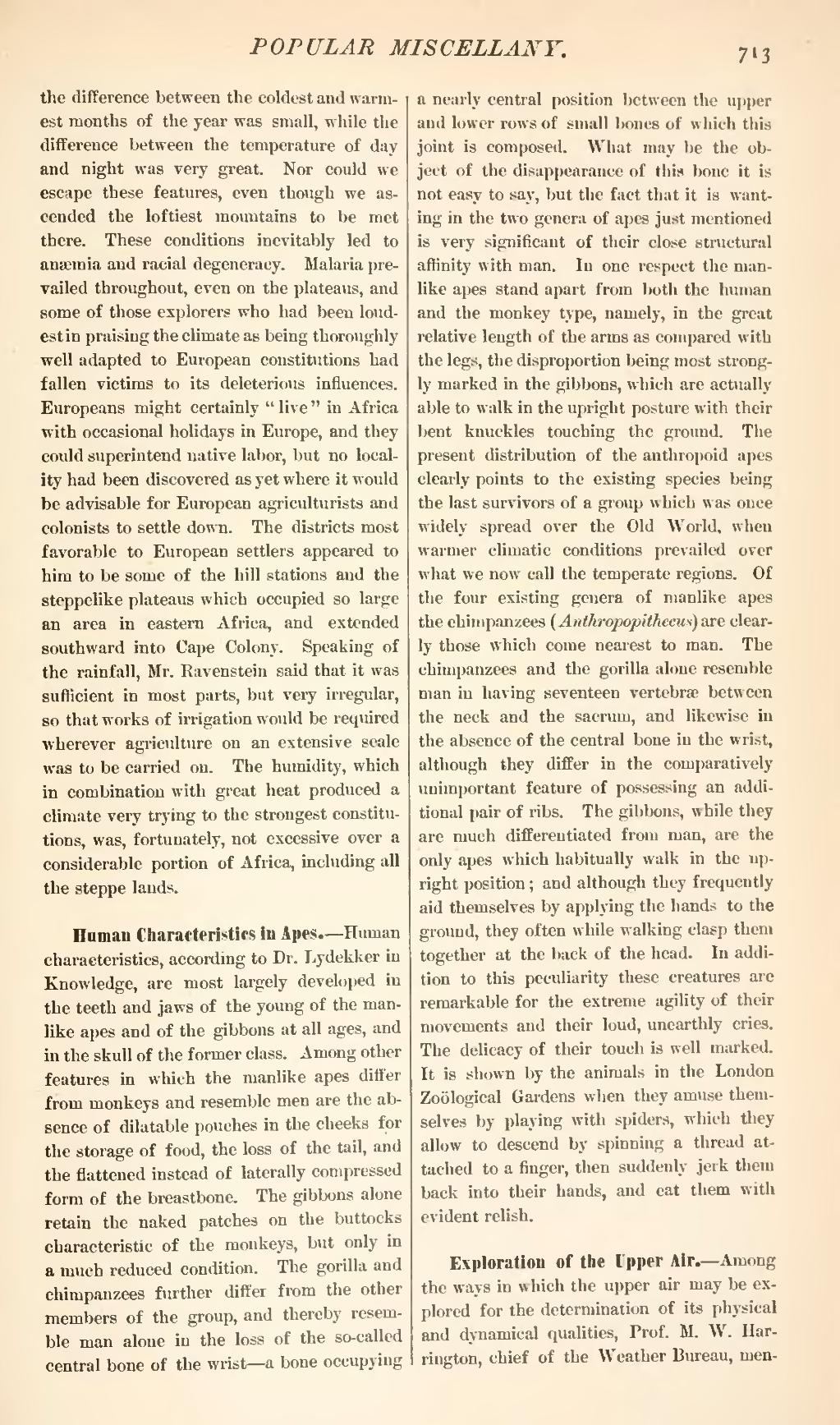the difference between the coldest and warmest months of the year was small, while the difference between the temperature of day and night was very great. Nor could we escape these features, even though we ascended the loftiest mountains to be met there. These conditions inevitably led to anæmia and racial degeneracy. Malaria prevailed throughout, even on the plateaus, and some of those explorers who had been loudest in praising the climate as being thoroughly well adapted to European constitutions had fallen victims to its deleterious influences. Europeans might certainly "live" in Africa with occasional holidays in Europe, and they could superintend native labor, but no locality had been discovered as yet where it would be advisable for European agriculturists and colonists to settle down. The districts most favorable to European settlers appeared to him to be some of the hill stations and the steppe-like plateaus which occupied so large an area in eastern Africa, and extended southward into Cape Colony. Speaking of the rainfall, Mr. Ravenstein said that it was sufficient in most parts, but very irregular, so that works of irrigation would be required wherever agriculture on an extensive scale was to be carried on. The humidity, which in combination with great heat produced a climate very trying to the strongest constitutions, was, fortunately, not excessive over a considerable portion of Africa, including all the steppe lands.
Human Characteristics in Apes.—Human characteristics, according to Dr. Lydekker in Knowledge, are most largely developed in the teeth and jaws of the young of the manlike apes and of the gibbons at all ages, and in the skull of the former class. Among other features in which the manlike apes differ from monkeys and resemble men are the absence of dilatable pouches in the cheeks for the storage of food, the loss of the tail, and the flattened instead of laterally compressed form of the breastbone. The gibbons alone retain the naked patches on the buttocks characteristic of the monkeys, but only in a much reduced condition. The gorilla and chimpanzees further differ from the other members of the group, and thereby resemble man alone in the loss of the so-called central bone of the wrist—a bone occupying a nearly central position between the upper and lower rows of small bones of which this joint is composed. What may be the object of the disappearance of this bone it is not easy to say, but the fact that it is wanting in the two genera of apes just mentioned is very significant of their close structural affinity with man. In one respect the manlike apes stand apart from both the human and the monkey type, namely, in the great relative length of the arms as compared with the legs, the disproportion being most strongly marked in the gibbous, which are actually able to walk in the upright posture with their bent knuckles touching the ground. The present distribution of the anthropoid apes clearly points to the existing species being the last survivors of a group which was once widely spread over the Old World, when warmer climatic conditions prevailed over what we now call the temperate regions. Of the four existing genera of manlike apes the chimpanzees (Anthropopithecus) are clearly those which come nearest to man. The chimpanzees and the gorilla alone resemble man in having seventeen vertebrae between the neck and the sacrum, and likewise in the absence of the central bone in the wrist, although they differ in the comparatively unimportant feature of possessing an additional pair of ribs. The gibbons, while they are much differentiated from man, are the only apes which habitually walk in the upright position; and although they frequently aid themselves by applying the hands to the ground, they often while walking clasp them together at the back of the head. In addition to this peculiarity these creatures are remarkable for the extreme agility of their movements and their loud, unearthly cries. The delicacy of their touch is well marked. It is shown by the animals in the London Zoölogical Gardens when they amuse themselves by playing with spiders, which they allow to descend by spinning a thread attached to a finger, then suddenly jerk them back into their hands, and eat them with evident relish.
Exploration of the Upper Air.—Among the ways in which the upper air may be explored for the determination of its physical and dynamical qualities. Prof. M. W. Harrington, chief of the Weather Bureau, men-
